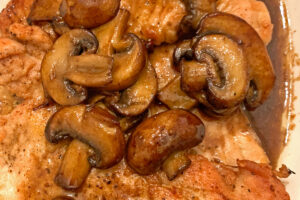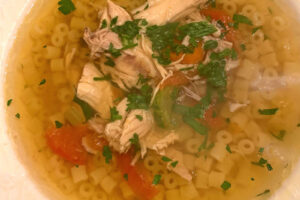This Three-Meat Ragù Bolognese is a riff on the original idea for Bolognese sauce. In America, we’ve erroneously come to call any tomato sauce with meat Bolognese. A meat sauce heavy on tomato should properly be called Salsa Napoletana, originating in southern Italy, where the tomato reigns supreme. A true Bolognese sauce uses a variety of meats and very little tomato. Also, in America you often find spaghetti alla Bolognese, something you will never see in Italy. The Italians prefer their Bolognese served over wide, flat fresh pastas, such as tagliatelle, fettucine, or pappardelle, which coat better with this sauce.
The first recipe for ragù Bolgonese was published in 1891 by Pellligrino Artusi. He called for the use of lean veal and pancetta, with no tomato at all. The recipe has since evolved and many variations are prevalent. In my Three-Meat Ragù Bolognese, I prefer the rich and flavorful combination of speck, Italian sausage, and ground beef. Speck, which comes form the Alto Adige (the Dolomite mountains) section of Italy, is similar to prosciutto, but it uses more spices (salt, pepper, juniper berries, and bay leaf) and is very lightly smoked.
Porcini mushrooms are an addition that Artusi recommended, and in my recipe they are essential to the flavor. Take one ounce of dried porcini mushrooms and soak them in about 1 1/2 cups of water for at least a half hour. Have the speck cut into one thick quarter-pound slice.

A thick slice of speck.
Then chop the speck into small dice.

Diced speck.
In a heavy casserole, gently fry the speck in a little olive oil until it begins to color, but is not crisp. If you are unable to find speck, substitute prosciutto, smoked ham, or pancetta.

Sauté the speck.
When the speck is ready, add the soffritto, which is minced onion, celery, carrot, and garlic, and cook over very low heat for about 15 minutes, covering the pot for the first 10 minutes. The garlic is not traditional, but I find it adds significant depth to the sauce.

Add the soffritto—carrot, celery, onion, and garlic.
When the soffritto is tender, add some minced parsley, thyme, marjoram, and a pinch of peperoncino. Then add a tablespoon of flour and cook for two more minutes. The flour, I find, helps meld all of the ingredients into an appealing consistency.
Remove the Italian sausages from their casing.

Remove the sausage meat from the casing.
In a separate frying pan, sauté the sausage and the ground beef in a tablespoon of olive oil, breaking into small bits until the meats are well seared.

Fry the ground meats.
Drain the porcini, reserving the soaking water.

Drain the porcini.
Chop the mushrooms and add to the fried ground meats, cooking for about 5 minutes.

Add the mushrooms to the ground meats.
Add white wine and cook for 5 minutes, scraping the bottom of the pan, until the wine has evaporated. Strain the mushroom-soaking water through a fine sieve lined with a damp paper towel. This removes any dirt or sediment from the liquid.

Strain the porcini liquid through a paper towel.
Add the ground meats to the soffritto mixture. Stir in 3-4 tablespoons of tomato paste, the beef broth, and about 1 cup of the mushroom-soaking liquid until well combined. Add some nutmeg, a teaspoon of sugar, and a little black pepper. Bring to a boil, then reduce the heat and simmer gently for about 2 hours, stirring frequently. If the mixture gets too dry, you may need to add the remainder of the porcini liquid and some water a bit at a time.
Just before ready to serve, stir in the heavy cream and unsalted butter.
Taste for seasoning. For Three-Meat Ragù Bolognese, I eliminate salt because I find both the sausage and speck add sufficient saltiness. I also abandon the traditional fresh tagliatelle, and substitute tortellini, either the meat or the cheese-filled variety. This was how I was first served the dish in a restaurant in Bologna, and I find it particularly delicious. If you can’t find fresh torellini, then use fresh tagliatelle, fettuccine, or any small dried pastas. Some people like to serve this with Parmigiano, but I find the dish already so rich that it doesn’t really need the cheese.





